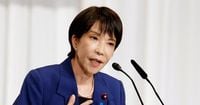Japan is on the cusp of a political turning point as the ruling Liberal Democratic Party (LDP) prepares for a crucial leadership election on October 4, 2025. The outcome will not only determine the party’s next leader but could also set the course for the nation’s future amid mounting economic, social, and political challenges. For the first time in its history, Japan could see a woman, Sanae Takaichi, take the helm as prime minister—if she can overcome her rivals, including Shinjiro Koizumi, who stands to become the youngest leader in postwar Japanese history.
According to Reuters, the LDP’s leadership race features five candidates, but polls of the party’s 295 lawmakers currently put Koizumi in the lead, with Takaichi trailing in third place. The final result, however, remains uncertain, hinging on last-minute shifts in intra-party support and turnout. The stakes are high, not just for the LDP but for Japan as a whole, which has seen four prime ministers in five years—a period marked by instability, scandal, and a dramatic decline in public trust.
The LDP has ruled Japan almost continuously for the past three decades, but its grip on power is slipping. In the last two parliamentary elections, the party lost its majority, as voters punished it for a series of high-profile scandals and its perceived failure to address the country’s economic woes. As CNN reports, public frustration is palpable. Many Japanese citizens, weary from repeated political scandals and soaring inflation, have turned to emerging right-wing parties like Sanseito, which captured 14 seats in the upper house after campaigning on a nationalist, anti-immigration platform.
“They are looking to try to change the face of the party, to get back voters that they’ve lost in the last two elections,” said Jeffrey Hall, a Japanese studies lecturer at Kanda University of International Studies, in an interview with CNN. “In the past, voters often overlooked scandals, but now I think they’re very fed up with it. And the alternatives offered by other conservative parties, center-right or far-right parties have been more attractive to voters.”
Indeed, the LDP’s troubles began in earnest after the departure of Shinzo Abe, who stepped down as prime minister in 2020 and was assassinated in 2022. Abe’s nearly nine-year tenure is now remembered as a rare period of stability. Since then, the party has struggled to contain the fallout from a 2023 slush fund scandal involving millions of dollars in undocumented political funds and allegations of kickbacks. “The party hasn’t really done anything significant to change its ways, it hasn’t significantly punished politicians who were involved in these scandals,” Hall explained, highlighting the erosion of trust among voters.
Economic hardship has only deepened public discontent. The cost of rice, Japan’s staple food, has nearly doubled over the past year, despite government interventions such as releasing emergency reserves and importing foreign rice. Inflation and stagnant wages have made daily life more difficult, especially for the country’s aging population. As Hajime Kidera, a professor at Meiji University, told CNN, “Voters tend to lean more nationalist and conservative during economic downturns,” a dynamic that has fueled support for candidates who promise a return to the stability and pride associated with the Abe era.
Against this backdrop, the LDP’s leadership contest has become a battle not just for party control, but for the soul of Japanese politics. Takaichi, the former Minister of Economic Security, has built her campaign around an ambitious promise: to double Japan’s economy over the next decade through large-scale government investments in advanced technologies, infrastructure, and food production. She also advocates for strengthening trade ties with the United States, while insisting that existing agreements be reviewed if they are deemed unfair to Japan. Takaichi’s hawkish stance on security and diplomacy, combined with her conservative social views, has drawn comparisons to Margaret Thatcher—but not everyone is convinced. “Some skeptics view her as ‘more like a Liz Truss in that she could damage the economy,’” Hall noted.
Her main rival, Shinjiro Koizumi, currently serves as Minister of Agriculture and is seen as a moderate reformist. At 44, he would be the youngest prime minister since World War II, continuing a family legacy as the son of former Prime Minister Junichirō Koizumi. Koizumi has pledged to clean up politics, initiate constitutional reforms, and allow married couples to use separate surnames—a move Takaichi opposes. His willingness to work with the center-right Japan Innovation Party, which holds significant parliamentary influence, could help the LDP regain its footing in a fragmented legislature. “A Koizumi victory would suggest that the LDP believes he represents the ‘rebirth’ of the party and is most capable of winning younger generations of voters in the elections to come,” said Rintaro Nishimura, a senior associate at The Asia Group.
The third major contender, Chief Cabinet Secretary Yoshimasa Hayashi, is the party’s steady hand. With experience in defense, foreign affairs, and agriculture, Hayashi is seen as a reliable, if less dynamic, candidate. He may have an edge in international diplomacy, given his Harvard education and fluency in English. Yet, as Nishimura put it, Hayashi “is the ‘handyman’ who is called upon in times of crisis,” rather than a visionary leader.
Whoever wins the leadership contest faces daunting challenges. The LDP’s loss of majority means that its nominee is not guaranteed to become prime minister, as opposition parties remain divided but could potentially form a coalition. Hiroshi Shiratori, a professor at Hosei University, observed, “There is great talk about enlarging the coalition government—they might put another opposition party into that LDP-Komeito coalition to regain a parliamentary majority. So one of the issues is, who can make a good relationship with one of the opposition parties?”
Even if the LDP retains the premiership, the new leader will inherit a host of unresolved problems: persistent inflation, a rapidly aging population, a shrinking workforce, and ballooning costs for elder care and welfare. Japan’s demographic crisis is now a defining issue, with far-reaching implications for economic growth and social stability. Meanwhile, anti-foreigner sentiment and xenophobia have become flashpoints, driving support for nationalist parties and complicating Japan’s relationships with its neighbors, especially China and South Korea.
Internationally, the next leader must also navigate Japan’s alliance with the United States, now under the administration of President Donald Trump, and reassert the country’s presence on the world stage after years of perceived decline. The LDP’s internal divisions—between conservatives and moderates—are likely to persist, making party unity and effective governance an ongoing challenge.
As Jeffrey Hall summed up, “It doesn’t seem likely that whoever becomes prime minister can suddenly refresh the LDP and make it an inspiring party that the voters will back. It’s really hard to see Japan having stable leadership.”
With the LDP’s future—and perhaps Japan’s own political direction—hanging in the balance, all eyes are now on Tokyo as the party prepares to choose its next leader. The decision will reverberate far beyond the halls of parliament, shaping the country’s response to economic hardship, demographic change, and its place in an increasingly turbulent world.






